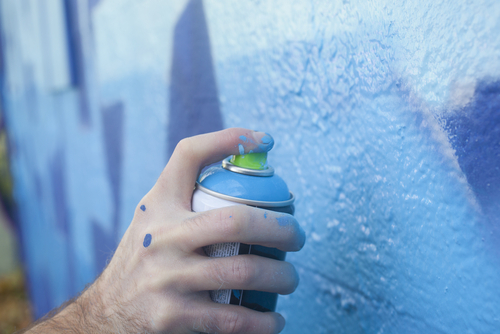Is Spray Paint Bad For You?
Short answer
Spray paint has good qualities that have to do with usefulness. When it comes to health, however, spray paint offers no benefits and can be deadly when inhaled excessively.
Category 'F' is for things that fail to bring anything beneficial to the table, and are very harmful to your health. We recommend completely avoiding anything in this category. Long-term side effects of 'F' items are usually very serious.
View Full Grading System
Category 'A'
Very healthy and numerous health benefits. Side effects are rare. Things rated an 'A+' are typically necessary for survival (for example, water).
Very healthy and numerous health benefits. A few harmful qualities may be associated, but only under certain circumstances such as an allergic reaction.
Very healthy and numerous health benefits. Harmful qualities may be associated, but aren't usually serious.
It is important to note that even the best things in life can become bad in immoderate amounts. So, although something may be rated an 'A+', overconsumption/overdoing can bring unwanted effects.
Category 'B'
Very beneficial to your health. Things rated a 'B+' may have a few harmful qualities to pay attention to.
Overall beneficial to your health. Things rated a 'B' may have some harmful qualities to pay attention to.
More beneficial to your health than not. However, harmful qualities are most likely associated and shouldn't be overlooked.
The main difference between category 'A' and category 'B' is the harmful qualities typically present in 'B' items. Serious side effects are usually uncommon, but are still possible and should be taken note of.
Category 'C'
Both beneficial and harmful qualities associated. Things rated a 'C+' are typically a bit more on the beneficial side. Still, moderation is important.
A fairly even ratio of beneficial and harmful qualities. Moderation is important. Very general topics that can lean towards both sides of the spectrum will be placed here as well. Rice, for example, can be good or bad depending on the type.
More harmful than beneficial. Side effects are common, especially when consumed/done excessively. Moderation is very important.
Category 'C' usually denotes to both good and bad qualities. When it comes to this category, it is important to keep this word in mind: moderation.
Category 'D'
Harmful to your health. Although benefits may be associated, the bad most likely outweighs the good. Moderation is very important.
Harmful to your health. A few benefits may be associated, but the bad outweighs the good. Moderation is extremely important.
Harmful to your health. Very few, if any, benefits are present. Things in this category should be avoided as much as possible.
Category 'D' is typically for things that are more harmful than beneficial. While consuming/doing something unhealthy once in a blue moon shouldn't hurt, we definitely recommend eliminating 'D' items as a regular part of your routine/diet.
Category 'F'
Category 'F' is for things that fail to bring anything beneficial to the table, and are very harmful to your health. We recommend completely avoiding anything in this category. Long-term side effects of 'F' items are usually very serious.
Category 'N'
'N' stands for neutral. Things placed into this category are generally (a) neither good nor bad for you, or (b) lack the necessary evidence to reach any conclusions.
Long answer
Spray paint is paint that is pushed out of an aerosol can by gases. Spray paint has been around since the 1950s and can be thought of as belonging to one of two categories: industrial spray paint and commercial spray paint. The same benefits and detriments are shared by both. First are the raw materials that make up spray paint – the pigments. There are four pigments present in spray paint: white pigments, colored pigments, inert pigments, and functional pigments. Spray paint also contains solvents and propellants, such as hydrofluorocarbons (HFCs) that push the paint out of the can. Furthermore, spray paints contain acetone, xylene, and toluene, which are known as volatile organic compounds (VOCs).
Spray paint is effective in that it can help a person finish a project faster, provide a more even coating, and comes in a wider variety when compared to other painting options. However, the effects on the body are terrible. Simply getting spray paint on your skin can cause irritation and burns, and if done over a long time can lead to asthma and lung cancer (in the rarest case). Inhalation can cause headaches, dizziness, and irritation of the respiratory tract, et al. Long-term effects of inhalation include CNS (central nervous system) dysfunction and serious damage of the respiratory system.
A few precautions you can take while using spray paint spraying in well-ventilated areas, preferably outdoors, and wearing a dust mask or a paint respirator.
So is spray paint bad for you? The answer depends on how the question is being asked. In the sense that it lets painters get work done more quickly and efficiently, then it is great. If we are considering solely the consequences to one’s health, then it is one of the worst things invented that is sold in stores and one wonders how it passes government regulation standards.
Possible short-term side effects
- headaches
-
dizziness
-
nausea
-
skin irritation
-
burning
-
difficulty breathing
-
tightness in chest
-
fatigue
-
vomiting and diarrhea
Possible long-term side effects
- cns dysfunction
-
lung cancer
-
asthma
-
allergic contact dermititis
-
painter's syndrome
-
damage to reproductive system
-
kidney damage
-
liver damage
Ingredients to be aware of
- acetone
-
xylene
-
toluene
-
hydrofluorocarbons
-
solvents
Benefits
- quick and easy to use
-
comes in a wide variety
Healthier alternatives
- nontoxic water-based spray paint
-
liquid paint
Please turn your Ad Blocker off to see this content. Thank you!
Thank you for your feedback!
Written by Jeff Volling
Published on: 12-29-2015
Last updated: 11-28-2023
Thank you for your feedback!
Written by Jeff Volling
Published on: 12-29-2015
Last updated: 11-28-2023

 Approved by
Approved by 















